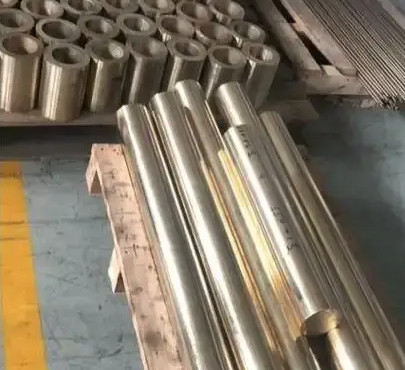Bronze, a copper-based alloy, is valued for its durability, corrosion resistance, and machinability. This guide provides a detailed exploration of bronze properties, its applications across industries, and CNC machining techniques, including specific parameters for optimal results. The content is structured to offer technical insights for engineers, machinists, and manufacturers seeking to work with bronze effectively.
Understanding Bronze: Composition and Properties
Bronze is primarily an alloy of copper and tin, with additional elements like aluminum, phosphorus, or nickel added to enhance specific characteristics. Its composition typically ranges from 60-90% copper and 10-35% tin, with other elements varying based on the alloy type. The mechanical properties of bronze make it suitable for demanding applications.
Key properties include:
- Corrosion Resistance: Bronze resists corrosion, particularly in marine environments, due to its copper content forming a protective oxide layer.
- Strength and Durability: With tensile strengths ranging from 350-800 MPa depending on the alloy, bronze is stronger than pure copper.
- Machinability: Bronze has a machinability rating of approximately 100% for alloys like C93200, making it easier to machine than steel.
- Low Friction: Lead-containing bronzes, such as C93200, exhibit self-lubricating properties, ideal for bearings.
- Thermal Conductivity: Bronze conducts heat effectively, with values around 40-70 W/m·K, suitable for heat-dissipating components.
Common bronze grades include:
| Alloy | Composition | Key Properties | Applications |
|---|---|---|---|
| C93200 (Bearing Bronze) | 83% Cu, 7% Sn, 7% Pb, 3% Zn | High machinability, self-lubricating | Bearings, bushings |
| C95400 (Aluminum Bronze) | 83% Cu, 10% Al, 4% Fe | High strength, corrosion resistance | Marine fittings, gears |
| C51000 (Phosphor Bronze) | 95% Cu, 5% Sn, 0.2% P | Wear resistance, electrical conductivity | Springs, electrical connectors |
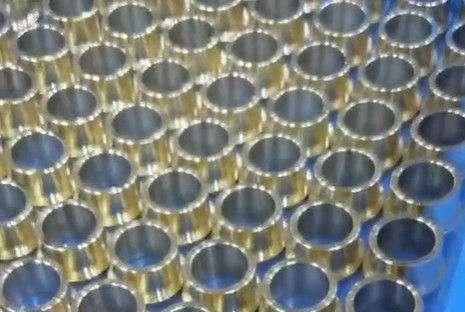
Applications of Bronze in Industry
Bronze is widely used across industries due to its mechanical properties and versatility. Below are its primary applications:
Marine Industry
Bronze, particularly aluminum bronze (C95400) and silicon bronze, excels in marine environments due to its resistance to saltwater corrosion. Components like propellers, valves, and fittings benefit from bronze’s durability. For example, bronze propellers withstand cavitation and erosion, maintaining performance over extended periods.
Aerospace
In aerospace, bronze is used for landing gear bushings and hydraulic components. Alloys like C93200 provide high strength and wear resistance, ensuring reliability under high loads. Bronze’s non-sparking property also enhances safety in environments with flammable gases.
Electrical Engineering
Phosphor bronze (C51000) is favored for electrical connectors and springs due to its conductivity (15-20% IACS) and fatigue resistance. Its ability to maintain elasticity under continuous operation makes it ideal for high-performance electrical systems.
Automotive
Bronze is used in automotive applications for bearings, bushings, and valve guides. C93200 bearing bronze reduces friction in engine components, improving efficiency and longevity. Its self-lubricating properties minimize maintenance needs.
Industrial Machinery
Bronze gears, bearings, and bushings are critical in heavy machinery. Manganese bronze (C86300) offers high strength for components under heavy loads, such as in hydraulic systems and construction equipment.
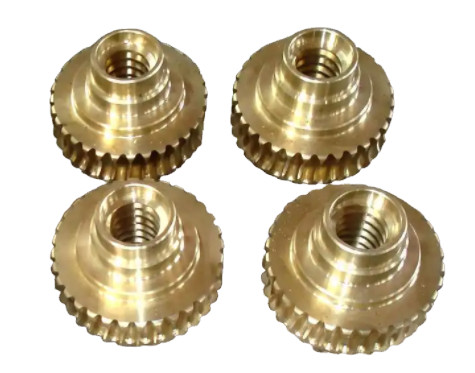
CNC Machining Bronze: Techniques and Parameters
CNC machining is the preferred method for shaping bronze due to its precision and efficiency. Below are the key techniques and recommended parameters for machining bronze effectively.
Material Selection
Choosing the appropriate bronze alloy is critical. For example, C93200 is ideal for bearings due to its lead content, while C95400 suits high-strength marine components. The alloy’s hardness (typically 60-90 HB for C93200) and grain structure influence tool selection and cutting parameters.
Tool Selection
Carbide tools with TiAlN coatings are recommended for their wear resistance and edge retention. High-speed steel (HSS) tools are suitable for softer alloys or detailed work. Tool geometry should include positive rake angles (5-10°) to reduce cutting forces and prevent galling.
Machining Techniques
Several CNC machining processes are used for bronze:
- Milling: Uses rotating cutters to remove material. Suitable for complex shapes like bushings. Parameters: spindle speed 300-600 SFM, feed rate 0.1-0.3 mm/rev, depth of cut 0.5-2 mm.
- Turning: Produces cylindrical parts like shafts. Parameters: spindle speed 400-800 SFM, feed rate 0.08-0.25 mm/rev, depth of cut 1-3 mm.
- Drilling: Creates precise holes. Use spiral-fluted carbide drills with a point angle of 118°. Parameters: spindle speed 200-400 SFM, feed rate 0.05-0.15 mm/rev.
- Broaching: Forms internal features like keyways. Parameters: cutting speed 10-20 SFM, feed rate 0.02-0.05 mm/stroke.
- Electrical Discharge Machining (EDM): Suitable for intricate contours. Uses electrical sparks to erode material, ideal for phosphor bronze components.
Coolant and Lubrication
Coolant is essential to manage heat and extend tool life. Water-soluble oil mist or synthetic coolants are recommended. For example, a 5-10% coolant concentration reduces thermal buildup during high-speed milling. Lubrication also prevents galling, especially in aluminum bronze.
Surface Finishing
Bronze parts can be finished to enhance aesthetics or functionality:
- As-Machined: Retains tool marks, suitable for non-cosmetic applications. Surface roughness: Ra 1.6-3.2 µm.
- Polishing: Achieves a glossy finish (Ra 0.4-0.8 µm) using felt wheels and jewelry polishing compounds.
- Bead Blasting: Creates a matte texture (Ra 1.2-2.5 µm) to conceal machining marks.
- Chemical Coatings: Applies protective layers to enhance corrosion resistance, e.g., patina for decorative parts.
| Technique | Spindle Speed (SFM) | Feed Rate (mm/rev) | Depth of Cut (mm) |
|---|---|---|---|
| Milling | 300-600 | 0.1-0.3 | 0.5-2 |
| Turning | 400-800 | 0.08-0.25 | 1-3 |
| Drilling | 200-400 | 0.05-0.15 | - |
Best Practices for Bronze Machining
To achieve high-quality bronze components, follow these best practices:
- Optimize Toolpaths: Use CAM software to create toolpaths that minimize heat generation and tool engagement. For example, trochoidal milling reduces tool wear in complex shapes.
- Chip Management: Employ chip breakers to control long, stringy chips, especially in leaded bronzes. Vacuum systems or air blasts can clear chips from the workspace.
- Workpiece Stability: Securely clamp the workpiece to prevent vibration, which can cause inaccuracies. Use soft jaws or custom fixtures for irregular shapes.
- Quality Control: Inspect parts using calipers, micrometers, or coordinate measuring machines (CMM) to ensure tolerances (e.g., ±0.02 mm for milling).
- Maintenance: Regularly check tools for wear and sharpen or replace them to maintain precision. For carbide tools, regrind after 50-100 hours of use.
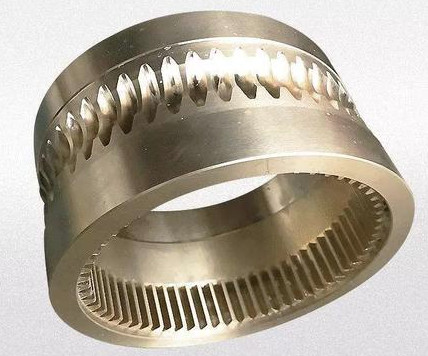
Safety and Regulatory Considerations
Safety is critical when machining bronze. Key measures include:
- Ventilation: Use proper ventilation to remove bronze dust, which can be hazardous if inhaled.
- Protective Gear: Wear safety goggles, gloves, and hearing protection to guard against chips and noise.
- Fire Safety: Keep fire extinguishers nearby, as machining sparks can ignite flammable materials.
For aerospace and marine applications, bronze parts must comply with standards like AMS (aerospace) or ASTM/ISO (marine). Chemical testing and traceability documentation ensure regulatory compliance.
Cost Optimization
Bronze machining can be expensive due to material costs and tool wear. To optimize costs:
- Select alloys matching application needs to avoid over-specification.
- Use standard stock sizes to minimize waste.
- Optimize CNC programs to reduce cycle times and tool wear.
- Outsource high-volume or specialized jobs to shops with advanced equipment.
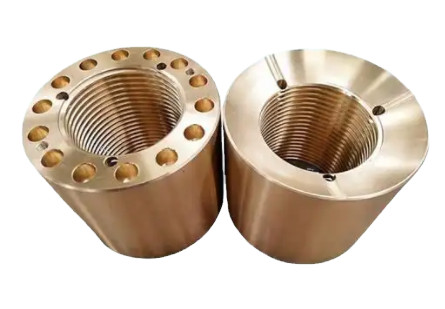
Conclusion
Bronze remains a cornerstone material in manufacturing due to its strength, corrosion resistance, and machinability. By understanding its properties, selecting appropriate alloys, and applying precise CNC machining techniques with optimized parameters, manufacturers can produce high-quality components for marine, aerospace, electrical, and industrial applications. Adhering to best practices and safety measures ensures efficiency and compliance, making bronze a reliable choice for precision parts.
